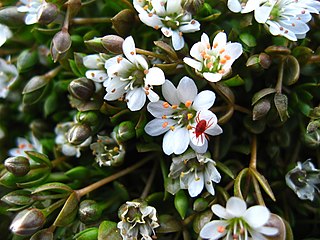
Scaevola is a genus of flowering plants in the Goodenia family, Goodeniaceae. It consists of more than 130 species, with the center of diversity being Australia and Polynesia. There are around 80 species in Australia, occurring throughout the continent, in a variety of habitats. Diversity is highest in the South West, where around 40 species are endemic.
There are over 190 vascular plant species on the Norwegian Arctic archipelago of Svalbard. This figure does not include algae, mosses, and lichens, which are non-vascular plants. For an island so far north, this number of species constitutes an astonishing variety of plant life. Because of the harsh climate and the short growing season, all the plants are slow growing. They seldom grow higher than 10 cm (4 in)

Arenaria is a genus of flowering plants, within the family Caryophyllaceae.

Arenaria balearica, the mossy sandwort, is a species of flowering plant in the family Caryophyllaceae, native to the Balearic Islands, Corsica, Sardinia and mainland Italy. It was first described by Carl Linnaeus in 1768.

Ammophila arenaria is a species of grass in the family Poaceae. It is known by the common names marram grass and European beachgrass. It is one of two species of the genus Ammophila. It is native to the coastlines of Europe and North Africa where it grows in the sands of beach dunes. It is a perennial grass forming stiff, hardy clumps of erect stems up to 1.2 metres (3.9 ft) in height. It grows from a network of thick rhizomes which give it a sturdy anchor in its sand substrate and allow it to spread upward as sand accumulates. These rhizomes can grow laterally by 2 metres in six months. One clump can produce 100 new shoots annually.

Grevillea humifusa, commonly known as spreading grevillea, is a species of flowering plant in the family Proteaceae and is endemic to a restricted area of the south-west of Western Australia. It is a prostrate shrub with long, trailing stems, divided lives with linear lobes and clusters of pink to pale red and cream-coloured flowers with a reddish, yellow-tipped style.

Stellaria humifusa, the saltmarsh starwort, is plant native to northern North America and Eurasia.
Arenaria grandiflora subsp. bolosii is a species of plant in the family Caryophyllaceae. It is endemic to Spain. Its natural habitat is Mediterranean-type shrubby vegetation. It is threatened by habitat loss.
Arenaria nevadensis is a species of flowering plant in the family Caryophyllaceae. It is endemic to Spain. Its natural habitat is Mediterranean Matorral shrubby vegetation. It is threatened by habitat loss.

Opuntia humifusa, commonly known as the devil's-tongue, eastern prickly pear or Indian fig, is a cactus of the genus Opuntia present in parts of the eastern United States, Mississippi and northeastern Mexico.
Eremogone macradenia is a species of flowering plant in the family Caryophyllaceae known by the common names Mojave sandwort and desert sandwort.

Eremogone ursina is a species of flowering plant in the family Caryophyllaceae known by the common name Bear Valley sandwort.

Styphelia humifusa, commonly known as native cranberry or cranberry heath, is a small prostrate shrub or groundcover in the heath family Ericaceae. The species is endemic to south-eastern Australia.

Houstonia humifusa, commonly called matted bluet, is a plant species in the coffee family (Rubiaceae). It is native to the United States, where it is found in Texas, Oklahoma, and New Mexico. It is typically found in sandy areas, or sometimes over gypsum.

Resnova humifusa is a species of flowering plant in the Asparagaceae family. It is a bulbous perennial plant, native to the Northern Provinces and KwaZulu-Natal in South Africa.

Scaevola humifusa is a prostrate shrub in the family Goodeniaceae, native to Western Australia. It grows to a height of 0.01 to 0.5 m, and its white-cream/white-blue flowers may be seen from August to November or January.

Arenaria pseudofrigida is a species of flowering plant belonging to the family Caryophyllaceae.
Camarea is a genus of flowering plants belonging to the family Malpighiaceae.
Cycniopsis is a genus of flowering plants belonging to the family Orobanchaceae.

Oenothera humifusa, the seabeach evening primrose, is a species of flowering plant in the family Onagraceae. It is native to the beaches of Bermuda and the eastern United States from Louisiana to New Jersey, and it has been introduced to Cuba. It is a decumbent perennial.














